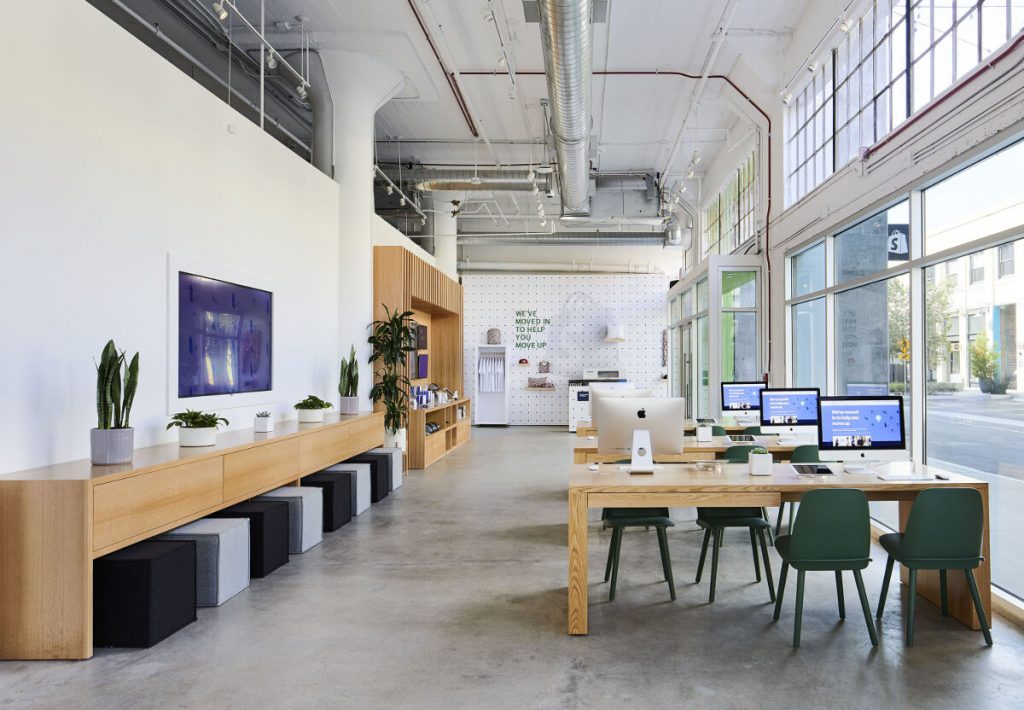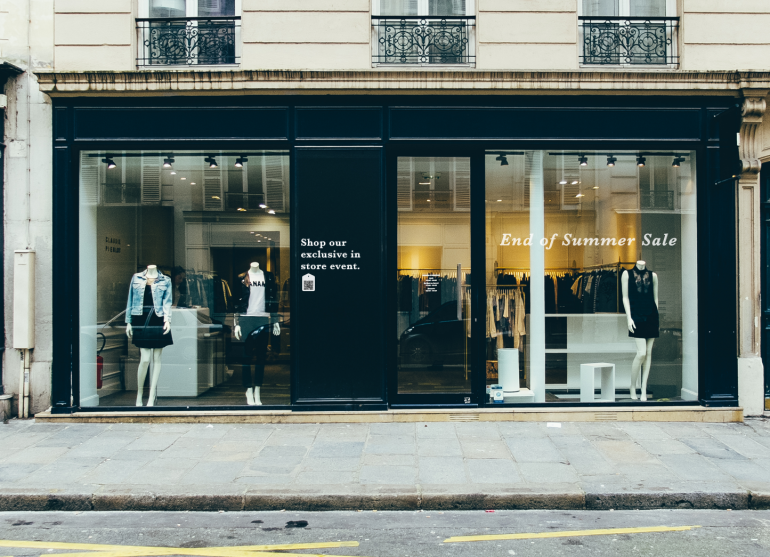Founded as an ecommerce company more than a decade ago, Shopify is looking to become much more than an online platform. Recently hiring a new director of retail, Shopify continues to expand its retail presence in its quest to become the hub for all merchants.
Shopify has been quietly growing its retail product line over the past few years, making strategic announcements to increase its presence in the market.
“The series of big product investments are targeted around people that have expanded into, or are starting with, brick and mortar.”
Last May, at Unite (the company’s annual partner and developer conference), Shopify put the spotlight on a number of its point-of-sale (POS) and payments platform services, and also revealed new services for its brick-and-mortar merchants. The Ottawa-based company announced a new Tap & Chip Reader, and upgraded its POS and payments services to support a number of physical retail functions, including multi-channel returns and exchanges, in-store pickup, a developer SDK, and support for inventory, orders, and fulfillment.
“The series of big product investments that [Shopify] made are really targeted around people that have expanded into, or are starting with, brick and mortar spaces,” Satish Kanwar, VP of product at Shopify, told BetaKit.
This dive into the physical retail space is now being led by Ian Black, Shopify’s new director of retail, and former head of UberEATS North America. Black will drive the business and go-to-market strategy for Shopify Retail, overseeing sales, solutions, partnerships, and operations, while also working alongside marketing and R&D leadership.
As the former head of UberEATS, Black brings more than four years of experience transitioning restaurants into an ecommerce world. Shopify is hoping to leverage his experience to help the company better understand the needs of brick-and-mortar retailers.

“It’s important to think about retail as multi-channel. As we work with our retailers, they don’t necessarily think about selling to customers in any one channel, they want to be able to [operate] in a variety of ways,” Black told BetaKit. “Shopify is [trying to] have all the pieces in place for them to be able to do that.”
RELATED: Shopify’s Satish Kanwar says ‘hybrid’ retail requires brands to be flexible
Black noted that across the company, Shopify teams are working closely in order to provide “very integrated and very seamless” solutions for retailers, regardless of whether they start as a brick-and-mortar store, a pop-up, online store, or through social media.
“Retailers don’t necessarily think about selling to customers in any one channel, they want to be able to [operate] in a variety of ways.”
“There are different challenges that [physical retailers] have and there will be different things that they need from Shopify when onboarding to our solutions, visiting our physical spaces, or setting up payments hardware,” Kanwar said. He added Shopify’s investment in the retail space is recognition that a number of its customers are primarily physical retailers or digitally native brands that are now moving into the brick-and-mortar space.
The pair see vast opportunity for Shopify to grow in the brick-and-mortar retail market. It’s Shopify’s goal, stated Black, to span the entire ecosystem to meet the needs of all its merchants. He emphasized that it doesn’t matter if merchants approach Shopify from a Shopify Plus standpoint or from Shopify Retail, the company hopes to create seamless solutions that span both markets.
“We want to make sure that we take all of the years of work we’ve been doing for [Shopify Plus] customers and make sure we deliver it to them in a way that makes sense and helps them with their unique problems. Shopify Plus did that for the enterprise and Shopify Retail will do that for the physical region,” Kanwar stated.
With dedicated teams focused on online merchants, and Black and his team focused on the physical merchants within Shopify’s ecosystem, Kanwar spoke to the ways these teams can work hand-in-hand.
“It’s not black and white where one specific type of customer falls. We have physical retail customers that are using Shopify Plus [and] they still need access to our hardware solutions,” Kanwar said. “We will commonly have Shopify Plus enterprise customer who extends its physical retail as a secondary channel, and we’ll work with our retail teams to get them where they want to be.”

Shopify’s new commitment to physical retail follows a noticeable trend over recent years that has seen a number of digitally native brands jump into the physical space. Shopify opened its own physical store location in Los Angeles last year to serve as a hub for its products and services, providing support and education for retailers on its platform.
A Shopify spokesperson told BetaKit at the time that, “after five years of investing in real life programming such as ShopTalk, Retail Tour, and ShopClass, we know that face-to-face help makes a huge difference for our partners’ and merchants’ businesses.”
“We aim for Shopify to be the first thing that merchants open in the morning and the last thing that merchants close at night.”
Shopify Retail is designed specifically to work with those merchants, as well as brick-and-mortar-first merchants to provide them with omnichannel experiences. And if the ecommerce giant hopes to create an omnichannel retail experience, dominating both the online and physical retail space, it will need to expand into every aspect of the buying process, supporting the full stack of commerce needs.
According to Shopify’s most recent quarterly results, the company’s revenue was bolstered by its merchant solutions, including its POS card reader, and Tap & Chip Reader. Merchant solutions grew 67 percent year-over-year to more than $608 million USD in revenue, beating out its online subscription solutions, which despite growing 50 percent, brought in only $465 million USD comparatively. These fourth quarter results helped Shopify hit a record $1 billion USD in revenue in 2018.
“We aim for Shopify to be the first thing that merchants open in the morning and the last thing that merchants close at night,” Harley Finkelstein, Shopify’s chief operating officer said in an earnings call. “We want Shopify to be the heart and soul of a merchants’ business, helping them sell more, and work more efficiently, so they can focus on the things that really matter to them.”
As Shopify expands into the retail space, it will continue to butt heads with other big players in the payments and POS market. With more and more touchpoints filling out the full commerce stack, Shopify is coming face-to-face with companies like San Francisco-based Square, and fellow Canadian success story Lightspeed, which recently IPO’d. The company also faces friction from past partners, seen in its very public spat with Mailchimp, and Facebook’s recently launched checkout platform for Instagram. If Shopify truly wants to be the heart and soul of commerce, now is a bad time to be making enemies.
RELATED: Lightspeed Retail launches platform combining brick-and-mortar and ecommerce experience
Kanwar noted to BetaKit that Shopify’s strategy isn’t just about simply building out its products for the sake of growth, however. The VP said the company is focused on creating more opportunity for the Shopify ecosystem, building up its partners, and having them grow alongside Shopify.
Kanwar also noted that Shopify’s focus on retail has two important aspects. One is helping its partners and app developers, like Bold Commerce (which recently closed an unprecedented Series A round) integrate its payments solutions instead of going to third parties. Second, Shopify also hopes to make it easier for its merchants to set up retail experience using Shopify’s POS system.
“It’s hard to overstate the size of the opportunity and it’s certainly always our mission to first build the best product for our merchants,” Black emphasized.
RELATED: Shopify won the holidays because Boxing Day lost to Black Friday (CanCon ep. 137)
A lot of Shopify’s focus and growth in the retail space will take place in Toronto. Black and his team are based out of the city, and a number of the new product announcements surrounding retail, including payments hardware have come from the Toronto product development teams.
Shopify first opened its Toronto office six years ago, and has since opened an R&D centre in the city to accommodate its growing employee base. In September, Shopify committed $500 million in investment to expand its presence in the city. The pair noted that the company’s investment in retail will continue to grow in Toronto under Black’s leadership.
Kanwar also hinted that the coming months should bring more announcements regarding Shopify’s retail-focused products and solutions. He noted “exciting things in the works” for more payments and POS features to help Shopify pursue its goal of becoming that one-stop-shop for ecommerce and retail.


